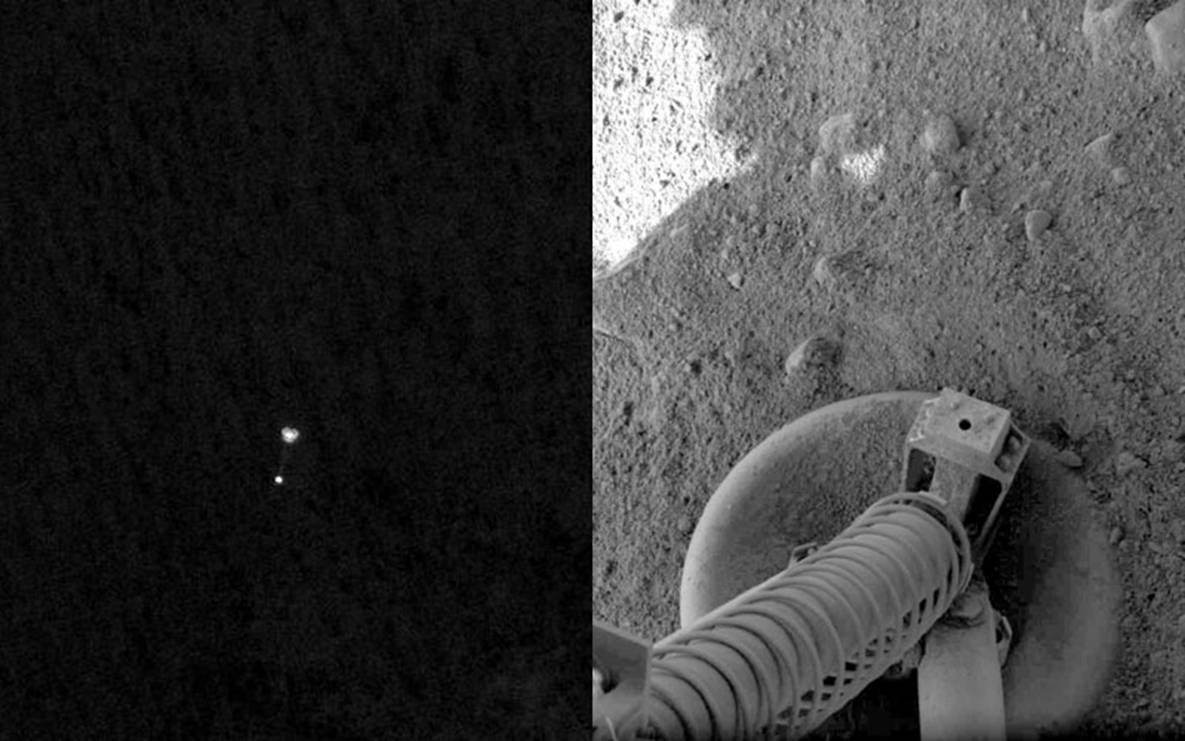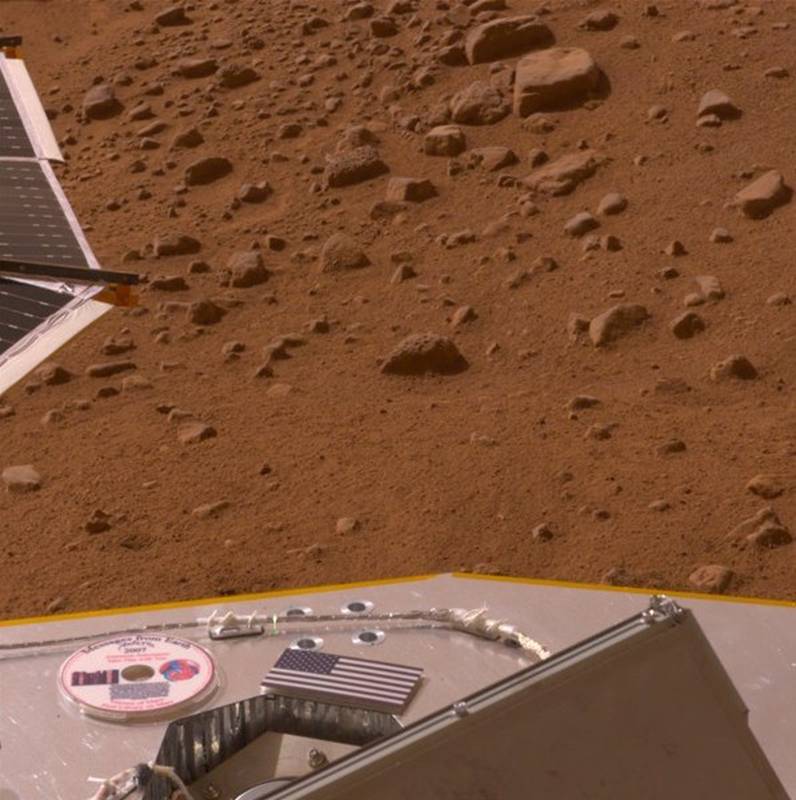News of Scientific Events
Phoenix Lands on Mars
|
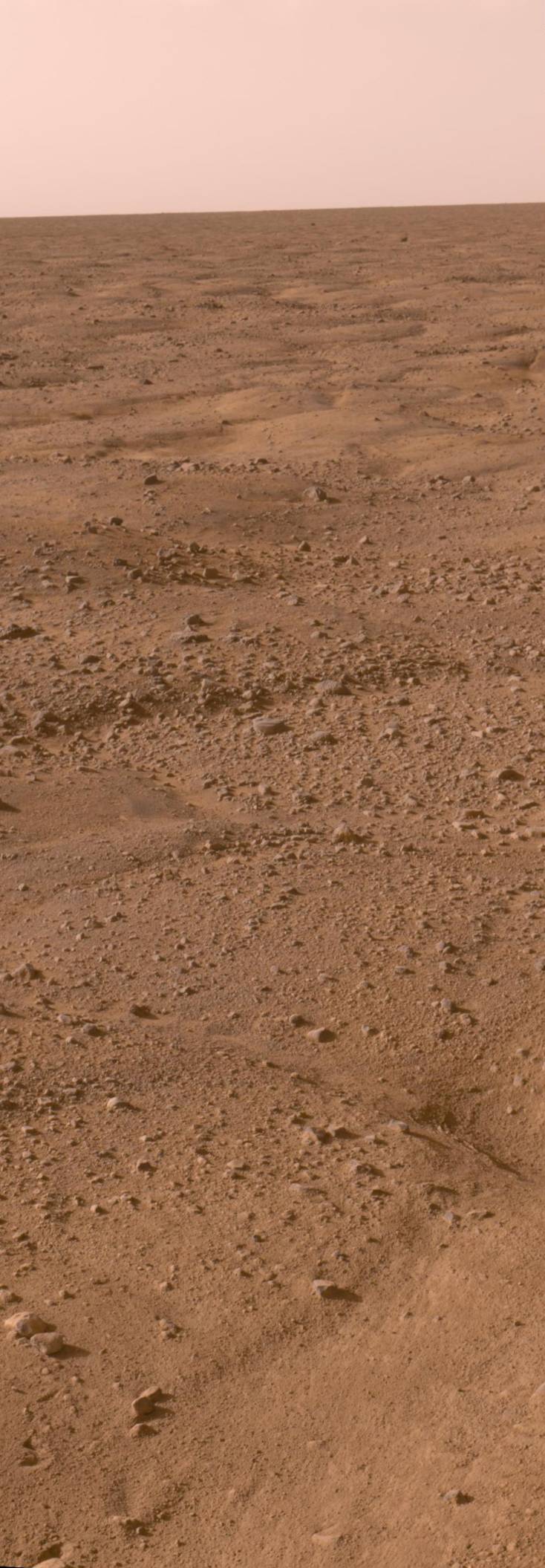 After 295 days, 13 hours, 34 minutes and 30 seconds (approximately) of the most quiescent cruise of a spacecraft I have ever had the privilege of seeing, at 23:01:03 UTC, the Phoenix lander jettisoned it's cruise stage and began it's slew to it's final entry attitude at Mars. Less than a minute later, it turned on it's UHF radio and sent a signal to it's sister craft Odyssey (more than 6 years after originally planned) which was recorded all the way to the surface. The entire entry descent and landing could not have been much closer to perfect. After peak loads at max Q of less than 9 G's, the lander slowed to 403 meters per second and deployed the parachute, just seven seconds later than the monte carlo mean published the morning prior to landing. Three point nine seconds after deploy, Phoenix experienced a swing rate of 89 degrees per second, high, but within the design limits. 15 seconds after deploy, the heatshield was released followed 10 seconds after that by the legs. Then came what was for me a sobering reminder of history. At 23:35:11.568, 421 milliseconds after deployment, Leg 2 indicated a transient long enough to declare touchdown had the touchdown monitor not been redesigned to reject transients until just above the ground. Then, as if to prove a point, Leg 3 also returned a deploy transient long enough to have declared touchdown 398 milliseconds after release. If MPL had made it this far, it's fate would have been sealed. But Phoenix continued on. At 23:37:20.931, the landing radar locked up on the ground, again only 8 seconds later than the monte carlo mean and 40 seconds after only a single power cycle while it searched for the ground. At 23:37:42, the lander dropped out of the backshell at an altitude of 960 meters, only 24 meters below the predicted mean. As I watched the velocity and altitude plots and listened to Richard Kornfeld call out the altitude over the net, I began to let myself hope Phoenix would make it. By 23:38:10, the lander was below 40 m altitude, and the velocity continued to drop along a well behaved curve for the next 13 seconds. Phoenix had made it past the point where MPL likely shut off it's engines. Now it only had to detect (and survive) touchdown.
After 295 days, 13 hours, 34 minutes and 30 seconds (approximately) of the most quiescent cruise of a spacecraft I have ever had the privilege of seeing, at 23:01:03 UTC, the Phoenix lander jettisoned it's cruise stage and began it's slew to it's final entry attitude at Mars. Less than a minute later, it turned on it's UHF radio and sent a signal to it's sister craft Odyssey (more than 6 years after originally planned) which was recorded all the way to the surface. The entire entry descent and landing could not have been much closer to perfect. After peak loads at max Q of less than 9 G's, the lander slowed to 403 meters per second and deployed the parachute, just seven seconds later than the monte carlo mean published the morning prior to landing. Three point nine seconds after deploy, Phoenix experienced a swing rate of 89 degrees per second, high, but within the design limits. 15 seconds after deploy, the heatshield was released followed 10 seconds after that by the legs. Then came what was for me a sobering reminder of history. At 23:35:11.568, 421 milliseconds after deployment, Leg 2 indicated a transient long enough to declare touchdown had the touchdown monitor not been redesigned to reject transients until just above the ground. Then, as if to prove a point, Leg 3 also returned a deploy transient long enough to have declared touchdown 398 milliseconds after release. If MPL had made it this far, it's fate would have been sealed. But Phoenix continued on. At 23:37:20.931, the landing radar locked up on the ground, again only 8 seconds later than the monte carlo mean and 40 seconds after only a single power cycle while it searched for the ground. At 23:37:42, the lander dropped out of the backshell at an altitude of 960 meters, only 24 meters below the predicted mean. As I watched the velocity and altitude plots and listened to Richard Kornfeld call out the altitude over the net, I began to let myself hope Phoenix would make it. By 23:38:10, the lander was below 40 m altitude, and the velocity continued to drop along a well behaved curve for the next 13 seconds. Phoenix had made it past the point where MPL likely shut off it's engines. Now it only had to detect (and survive) touchdown.
At 23:38:23.954, the computer detected touchdown on all three legs simultaneously. Phoenix did not come to an immediate stop, there was a bit of a bounce. 141 milliseconds after detecting touchdown, enough weight was lifted off the legs to allow the sensors to transition back to not touched down. It was a little bounce though, 78 milliseconds later, 2 legs transitioned back to touched down followed by the third another 176 milliseconds later. Phoenix had come to rest, upright on the Martian surface, with a mere quarter degree of tilt and less than a degree off the preprogram landed azimuth. The lander continued to relay the first 63 seconds of activity through Odyssey as planned, and then powered off the radio. At the Earth UHF station at Greenbacks, Peter Ilott watched for the 20 second UHF beep that would have signaled a safemode entry, but saw none. The lander completed the landed init sequence and shutdown 62 minutes and 45 seconds after touchdown, but back on Earth, we didn't know yet. The lander booted on time as programmed, and at 01:28:35 UTC, began to relay the rest of the post touchdown information to Odyssey which in turn relayed it to Earth. Despite over 16 minutes of latency, once the data reached the ground, it was displayed faster than we could read it all. Immediately, the screens showed the spacecraft was in nominal mode and the solar arrays had both deployed. There had been cheering and hugging up to that point, but that's when we knew all was well. Moments later, pictures projected on the big screens confirmed what the telemetry showed. The arrays had deployed, with timing just seconds less than they had in Earth ambient ATLO system level testing nearly two years ago.
|
For those that don't know, depending on how you count missions and spacecraft, humans have launched 38 missions to Mars, including nearly 20 landers. Phoenix represents only the 6th time we have succeeded, and the first time in over 30 years we have successfully soft landed. Not only did Phoenix fly right down the middle of almost every parameter, it achieved many firsts. It's payload fraction of nearly 1/6th it's landed mass and around 1/12th of it's launch mass is a first for Mars. The solar arrays have a w/kg 3 times greater than previous mars landers. It's the first successful landing at the Martian North Pole. And if the pictures the SSI and RAC have returned of the area under the lander turn out to be what they look like, Phoenix will have discovered water ice, literally at the surface, of another planet. And speaking of firsts, how about that incredible shot the MRO/HIRISE team took of our lander on the parachute.
Ladies and gentlemen, this was not just a successful launch, cruise, EDL and initial deployment of the Phoenix lander; it has been ridiculously successful! Ludicrous. I keep asking Josh if one of the labs is feeding us simulated data but as he keeps pointing out, the tests never went this well. There can be only one reason;
The unwavering dedication and sacrifice of each and every one of you to settle for nothing less than perfection.
While it may be the 6th successful lander, Phoenix has achieved many firsts. I want so badly to go through everyone by name (and you thought this was already long), but let me just thank, and congratulate, every single one of you for the role you played in getting this lander successfully to Mars. You all know who you are and what your contribution is. You've earned the right to take some very justifiable pride in that contribution. In many ways, it has been tougher than others, certainly longer, but maybe that just makes it all the more satisfying. Like Barry said, there were may who thought we couldn't do it. Some of the quotes I have heard over the last twelve years included: "...that flexible array will never work…(1998)" "...that prop system will shake itself apart…(2004)" and "…will never fly that lander..(2001)." Yet, you have proved them all wrong. Amazing. Utterly, totally, amazing.
Peter, Barry, Robert, do you remember those long hours in the proposal war room? Did you ever dare to imagine it would go this well?
We're not done yet, and if the first 5 sols have been any indication, Phoenix will continue to amaze us. And if it does, it will continue to be the result of the talent and dedication of this absolutely world class team.
Please forward this to everyone I have left off.
To continued success……
Richard
Richard Warwick
System Design Lead
Phoenix Mars Lander Program
Lockheed Martin Space Systems Company
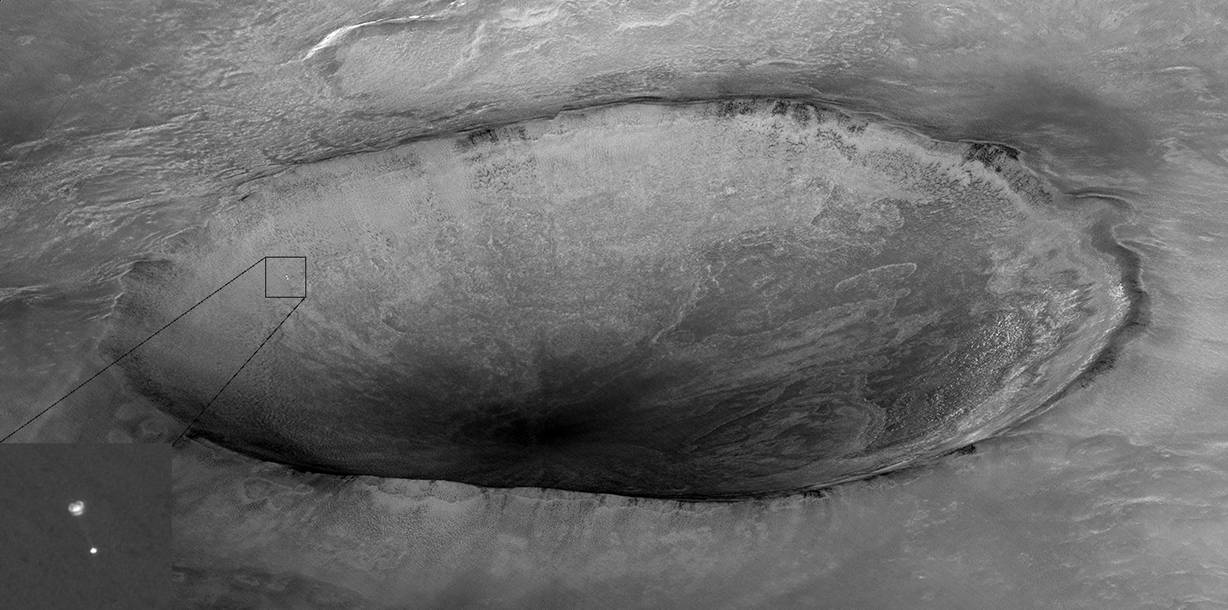
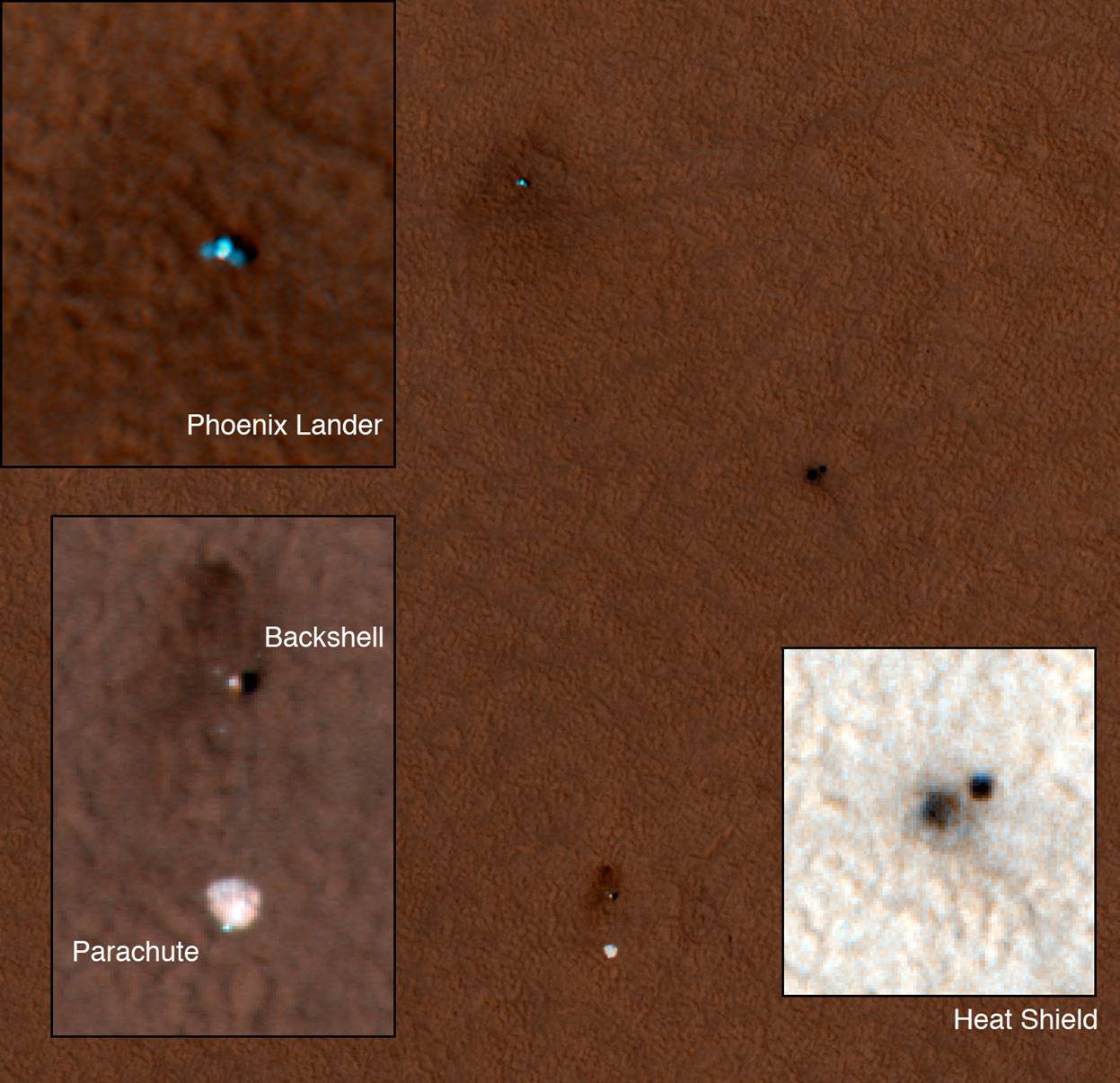
To give you a sense of scale of what you're seeing, the solar panels are about 5.5 meters (about 18 feet) across, and about 22 pixels in this image. The parachute and lander are about 300 meters, roughly 1,000 feet, apart. All seen and imaged by MRO from orbit. Amazing.
